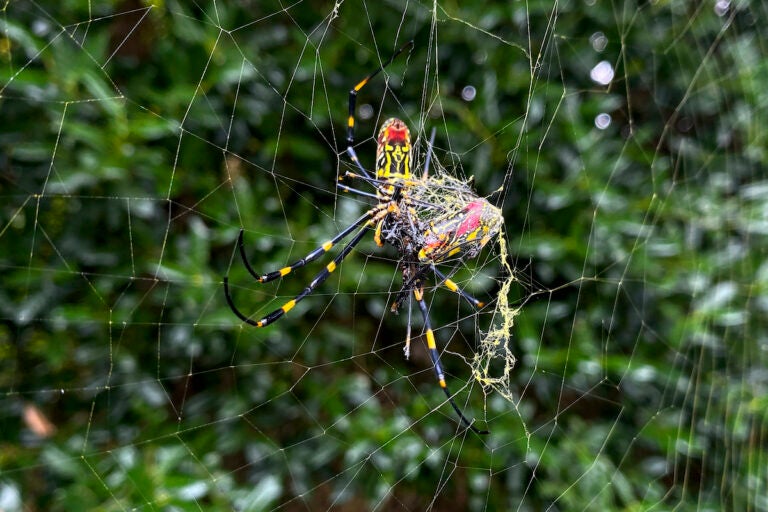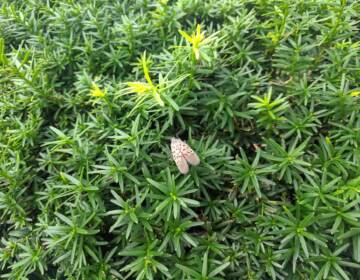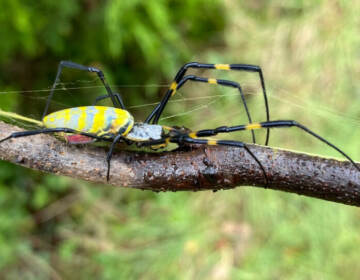They’re big. They’re colorful. But Joro spiders aren’t nightmare fodder
Populations have been growing in parts of the South and East Coast for years, and many researchers think it's only a matter of time before they spread to much of the U.S.

FILE - The Joro spider, a large spider native to East Asia, is seen in Johns Creek, Ga., Oct. 24, 2021. Populations of the species have been growing in parts of the South and East Coast for years now, and many researchers think it's only a matter of time before they spread to much of the continental U.S. (AP Photo/Alex Sanz, File)
A large, brightly colored invasive species called the Joro spider is on the move in the United States. Populations have been growing in parts of the South and East Coast for years, and many researchers think it’s only a matter of time before they spread to much of the continental U.S.
But spider experts say we shouldn’t be too worried about them.
“My sense is people like the weird and fantastic and potentially dangerous,” said David Nelsen, a professor of biology at Southern Adventist University who has studied the growing range of Joro spiders. “This is one of those things that sort of checks all the boxes for public hysteria.”
Scientists instead worry about the growing prevalence of invasive species that can do damage to our crops and trees — a problem made worse by global trade and climate change, which is making local environmental conditions more comfortable for pests that previously couldn’t survive frigid winters.
“I think this is one of those ‘canary in the coal mine’ type species where it’s showy, it’s getting a lot of attention,” said Hannah Burrack, professor and chair of the entomology department at Michigan State University. But the shy critter poses little risk to humans. Instead, Burrack said, introduced pests like fruit flies and tree borers can do more damage.
“This is a global concern, because it makes all the things that we do in terms of conservation, in terms of agricultural production, in terms of human health, harder to manage,” she said.
What is the Joro spider?
The Joro spider is one of a group of spiders called orb-weavers, named for their wheel-shaped webs. They’re native to East Asia, have bright yellow and black coloring and can grow as long as three inches (8 cm) when their legs are fully extended.
However, they’re pretty hard to spot at this time of year because they’re still early in their life cycle, only about the size of a grain of rice. A trained eye can spot their softball-sized webs on a front porch, or their gossamer threads of golden silk blanketing the grass. Adults are most commonly seen in August and September.
Where are they headed?
Scientists are still trying to figure that out, said David Coyle, an assistant professor at Clemson University who worked with Nelsen on a study on the Joro’s range, published last November. Their central population is primarily in Atlanta but expanding to the Carolinas and southeastern Tennessee. A satellite population has taken hold in Baltimore over the last two years, Coyle said.
As for when the species will become more prevalent in the Northeast, an eventual outcome suggested by their research? “Maybe this year, maybe a decade, we really don’t know,” he said. “They’re probably not going to get that far in a single year. It’s going to take a bunch of incremental steps.”
Can they fly?
The babies can: using a tactic called “ballooning,” young Joro spiders can use their webs to harness the winds and electromagnetic currents of the Earth to travel relatively long distances. But you won’t see fully-grown Joro spiders taking flight.
What do they eat?
Joro spiders will eat whatever lands in their web, which mainly ends up being insects. That could mean they’ll compete with native spiders for food, but it might not all be bad — a Joro’s daily catch could also feed native bird species, something Andy Davis, a research scientist at the University of Georgia, has personally documented.
As for some observers’ hope that Joro spiders could gobble up the invasive spotted lanternflies destroying trees on the East Coast? They might eat a few, but there’s “zero chance” they’ll make a dent in the population, Coyle said.
Are they dangerous to humans?
Joro spiders have venom like all spiders, but they aren’t deadly or even medically relevant to humans, Nelsen said. At worst, a Joro bite might itch or cause an allergic reaction. But the shy creatures tend to stay out of humans’ way.
What could one day truly cause damage to humans is the widespread introduction of other creatures like the emerald ash borer or a fruit fly called the spotted wing drosophila that threaten the natural resources we rely upon.
“I try to stay scientifically objective about it. And that’s a way to protect myself from maybe the sadness of it. But there’s so much ecological damage being done all over the world for, for so many reasons, mostly because of humans,” Davis said. “This to me is just one more example of mankind’s influence on the environment.”

Get daily updates from WHYY News!
WHYY is your source for fact-based, in-depth journalism and information. As a nonprofit organization, we rely on financial support from readers like you. Please give today.




